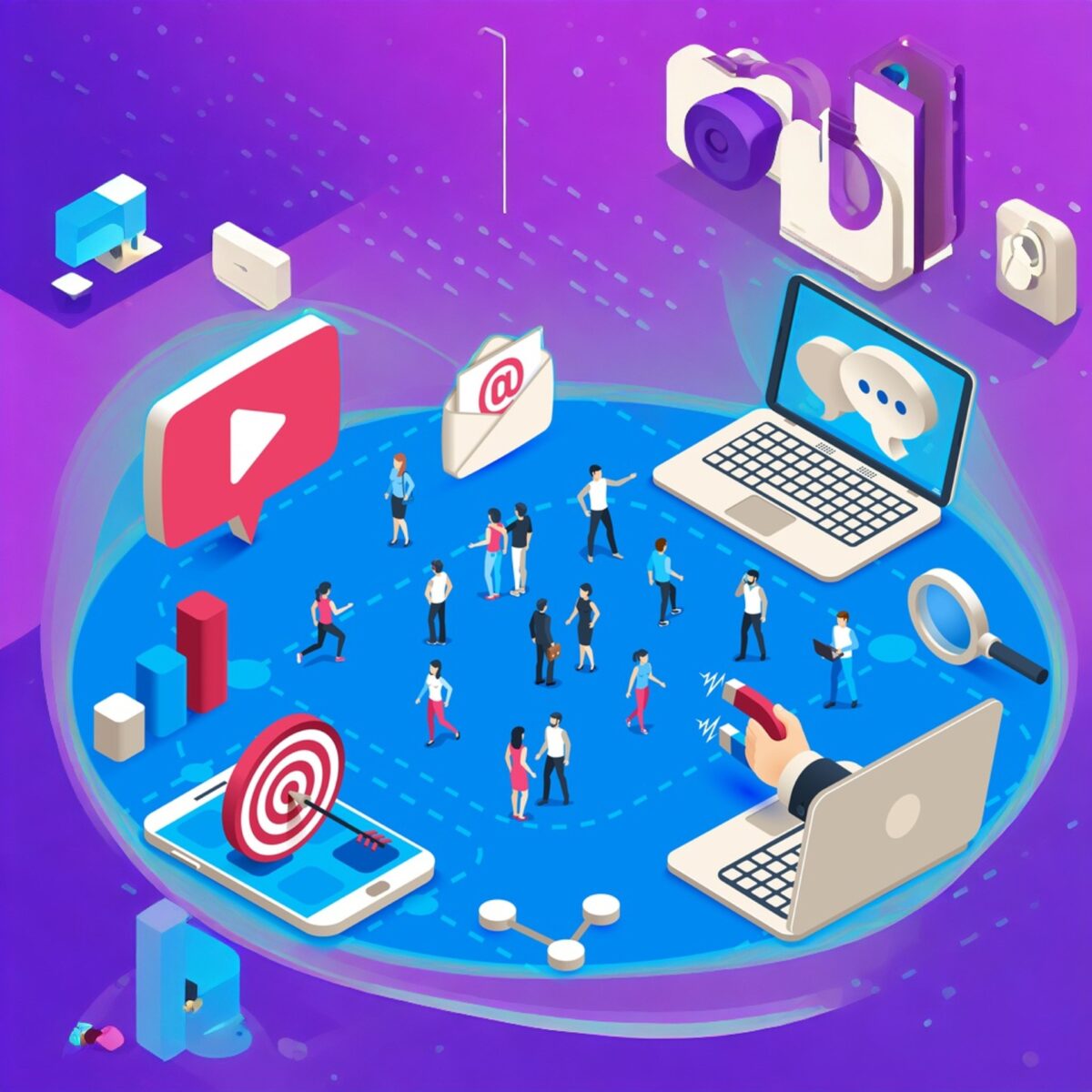By Elyse Flynn Meyer, Prism Global Marketing Solutions
CMO Huddles Partner
Inbound marketing has proven to be a powerhouse for B2B organizations. Companies can build trust, generate leads, and ultimately drive growth by attracting potential customers through valuable content and creating genuine connections. However, achieving meaningful results requires a strategic approach and a commitment to evolving practices. Here’s a detailed blueprint for senior marketing executives who want to amplify their inbound marketing efforts and fuel sustained growth in the B2B space.
1. Understand Your Buyer Personas Deeply
Inbound marketing starts with knowing exactly who you’re speaking to. In B2B, this process is more complex due to longer sales cycles, multiple decision-makers, and diverse organizational priorities. Unlike B2C, where buying decisions are often personal and immediate, B2B personas require a deeper understanding of industry trends, business challenges, and stakeholder motivations to create targeted, value-driven messaging that resonates across different roles and levels of influence.
Key Steps:
- Conduct Comprehensive Research: Use customer interviews, insights from the sales team, and analytics to understand your audience’s needs, pain points, and goals.
- Map Decision-Maker Journeys: Identify all stakeholders in the decision-making process—from end-users to executives—and tailor content to each persona.
- Update Personas Regularly: The B2B landscape evolves rapidly. Continuously refine personas based on new insights and market shifts.
2. Develop a Content Strategy Aligned with the Buyer Journey
Content drives inbound marketing, guiding prospects through each stage of the buyer’s journey—awareness, consideration, and decision. In the awareness stage, educational content builds trust. During consideration, detailed comparisons and insights address pain points. In the decision stage, case studies and testimonials provide proof of content or even offer a free trial, depending on your product or service offering. Tailoring content to each phase ensures engagement, nurtures leads and drives conversions.
Key Steps:
- Awareness Stage: Focus on content that educates and informs. Blog posts, white papers, and thought leadership pieces can position your brand as an industry expert.
- Consideration Stage: Provide comparative content, such as case studies, webinars, and in-depth guides, to address specific pain points.
- Decision Stage: Deliver content encouraging action, such as ROI calculators, testimonials, or free trial offers.
3. Embrace Data-Driven Personalization
Personalization isn’t just a nice-to-have—it’s a critical component of B2B marketing, where relationships, relevance, and trust drive decision-making. With longer sales cycles and multiple stakeholders involved, generic messaging falls flat. Tailoring content, outreach, and solutions to specific industries, roles, and pain points helps build credibility, foster engagement, and accelerate conversions by showing prospects that you truly understand their unique challenges and needs.
Key Steps:
- Segment Your Audience: Use CRM data and behavioral insights to create detailed audience segments.
- Dynamic Content Delivery: Utilize marketing automation tools to deliver personalized emails, landing pages, and recommendations.
- Analyze and Adjust: Continuously monitor engagement metrics to refine your personalization tactics.
4. Optimize for Search Engines and Beyond
SEO is the backbone of inbound marketing, ensuring your content reaches the right audience at the right time. However, true success goes beyond keywords—it’s about understanding and aligning with user intent. Search engines prioritize content that provides real value, so optimizing for both algorithms and human needs is essential. Businesses can more effectively attract, engage, and convert high-intent prospects by focusing on relevance, quality, and intent-driven optimization.
Key Steps:
- Keyword Research: Focus on long-tail keywords and phrases that reflect your audience’s intent.
- On-Page Optimization: Ensure all content is optimized for keywords, readability, and engagement.
- Build Backlinks: Collaborate with industry partners, publish guest posts, and create link-worthy content to boost domain authority.
- Voice and AI Search: Adapt content for emerging search trends, including voice and AI-powered search queries.
5. Leverage Multi-Channel Distribution
Content creation is only half the battle—its impact depends on strategic distribution. An effective inbound marketing strategy ensures content reaches the right audience through multiple touchpoints, including SEO, social media, email, and industry partnerships. By leveraging data-driven insights and audience preferences, businesses can maximize engagement, nurture leads, and drive conversions, ensuring valuable content doesn’t just exist but actively influences decision-making.
Key Steps:
- Social Media Amplification: Share content on platforms such as LinkedIn, X, and niche industry forums.
- Email Marketing: Use email to nurture leads with tailored content that addresses their stage in the buyer’s journey.
- Paid Promotion: Invest in paid search, social ads, and sponsored content to amplify reach.
- Partnerships: Collaborate with industry influencers and thought leaders to co-create and distribute content.
6. Implement Advanced Lead Nurturing Tactics
B2B buying cycles can be long and complex, often involving multiple stakeholders and extended decision-making processes. Effective lead nurturing keeps prospects engaged by delivering relevant, timely content that addresses their evolving needs and concerns. Through personalized email campaigns, retargeting, and valuable resources, businesses can build trust, maintain momentum, and guide leads through each stage of the funnel, ultimately increasing the likelihood of conversion.
Key Steps:
- Automated Workflows: Use marketing automation tools to create nurture sequences based on behavior and engagement.
- Content Scoring: Assign scores to leads based on interactions with your content to prioritize high-value prospects.
- Retargeting Campaigns: Re-engage prospects who’ve interacted with your website or content but haven’t converted.
7. Measure What Matters
Inbound marketing thrives on data, but not all metrics are created equal. To truly amplify your strategy, focus on key performance indicators (KPIs) that align with business goals rather than vanity metrics like sheer traffic or social likes. Track engagement, lead quality, conversion rates, and customer acquisition costs to measure real impact. Businesses can refine their approach, optimize campaigns, and drive meaningful, revenue-generating results by leveraging data-driven insights.
Key Metrics:
- Traffic Metrics: Monitor organic traffic, referral traffic, and time on site.
- Engagement Metrics: Track downloads, form submissions, and webinar attendance.
- Conversion Metrics: Measure lead-to-customer conversion rates, marketing-qualified leads (MQLs), and sales-qualified leads (SQLs).
- Revenue Metrics: Calculate ROI, customer acquisition cost (CAC), and lifetime value (CLV).
8. Foster Sales and Marketing Alignment
Inbound marketing success relies on a seamless handoff between marketing and sales, ensuring leads are nurtured and converted efficiently. Alignment between these teams means clear communication, shared data, and a unified lead qualification and follow-up strategy. When marketing delivers high-quality, sales-ready leads and sales continue the conversation with relevant insights, businesses can create a smoother buyer journey, improve conversion rates, and drive long-term growth.
Key Steps:
- Shared Goals and Metrics: Establish KPIs for which both teams are accountable.
- Regular Communication: Schedule meetings to review lead quality and campaign performance.
- Integrated Tools: Use shared CRM and marketing automation platforms to streamline workflows.
9. Embrace Emerging Technologies
Staying ahead in the competitive B2B landscape requires leveraging the latest technologies to enhance inbound marketing efforts. From advanced analytics and AI-powered insights to marketing automation and CRM systems, technology allows businesses to streamline processes, deliver personalized content at scale, and make data-driven decisions. By integrating innovative tools, companies can optimize campaigns, engage with prospects more effectively, and drive higher conversions and ROI.
Key Steps:
- AI-Powered Insights: Use AI tools for predictive analytics, content creation, and personalization.
- Conversational Marketing: Implement chatbots and conversational AI to engage prospects in real-time.
- Interactive Content: Develop quizzes, calculators, and interactive tools to boost engagement.
10. Continuously Experiment and Iterate
Inbound marketing is a dynamic, ever-evolving process that requires constant attention to stay effective. Regular experimentation with content, strategies, and tactics—coupled with ongoing optimization based on performance data—helps sustain growth. Businesses can adapt to changing market conditions, audience preferences, and emerging trends by testing new approaches, analyzing results, and refining campaigns. This iterative process ensures continued engagement, higher conversions, and long-term marketing success.
Key Steps:
- A/B Testing: Test headlines, CTAs, and landing page designs to improve conversions.
- Content Refresh: Update high-performing content to ensure relevance and SEO value.
- Feedback Loops: Gather insights from customers and sales teams to refine your approach.
Amplifying inbound marketing for B2B growth requires a strategic, data-driven approach that evolves with market trends and audience needs. By deeply understanding your audience, creating valuable content, leveraging technology, and aligning with sales, you can create a scalable inbound strategy that drives measurable results.
By adopting these practices, senior marketing executives can lead transformative change within their organizations. The road to success in inbound marketing is paved with innovation, collaboration, and an unwavering commitment to delivering value at every touchpoint.
About the Author: Elyse Flynn Meyer is the President & Founder of Prism Global Marketing Solutions, a HubSpot Platinum agency. She is the author of Mastering Inbound Marketing, a Complete Guide to Building a Results-Driven Inbound Strategy. She has expertise in digital marketing, demand generation, integrated marketing program development, and sales alignment. Her experience ranges from start-ups to Fortune 500s, and she holds degrees from The University of Arizona and executive certificates from Columbia, Cornell, and others. Elyse serves on several advisory boards, contributes to Forbes, and is a member of CHIEF and Pavilion.
GET IN TOUCH:
If you would like to schedule a time to connect with Elyse and her team about how you can amplify your inbound marketing program or get a free HubSpot portal audit if you’re a HubSpot user, you can click here or contact her at elyse.meyer@prismglobalmarketing.com.
You can also check out her book, Mastering Inbound Marketing, Your Complete Guide to Building a Results-Driven Inbound Strategy.

